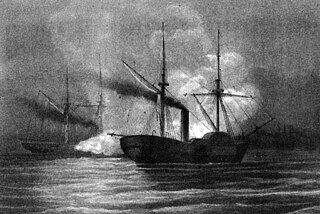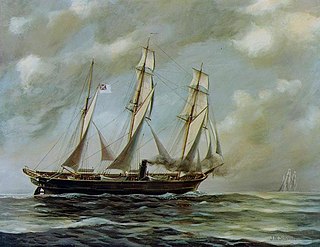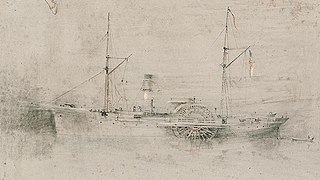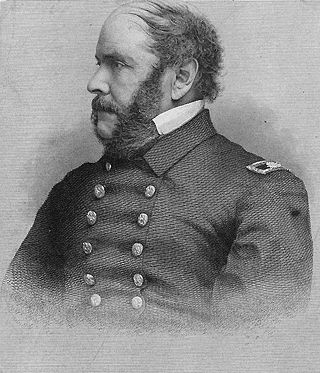
USS Kearsarge, a Mohican-class sloop-of-war, is best known for her defeat of the Confederate commerce raider CSS Alabama off Cherbourg, France during the American Civil War. Kearsarge was the only ship of the United States Navy named for Mount Kearsarge in New Hampshire. Subsequent ships were later named Kearsarge in honor of the ship.

Raphael Semmes was an officer in the Confederate Navy during the American Civil War. He was previously a serving officer in the US Navy from 1826 to 1860.

The very first USS Hatteras was a 1,126-ton iron-hulled steamer purchased by the Union Navy at the beginning of the American Civil War. She was outfitted as a gunboat and assigned to the Union blockade of the ports and waterways of the Confederate States of America. During an engagement with the disguised Confederate commerce raider, CSS Alabama, she was taken by surprise and was sunk off the coast of Galveston, Texas. The wreck site is one of the few listed on the National Register of Historic Places because of its location away from destructive surf and because of the ship's side-wheel design, which marks the transition between wooden sailing ships and steam-powered ships.

CSS Alabama, a screw sloop-of-war built in 1862 for the Confederate States Navy. The vessel was built in Birkenhead on the River Mersey opposite Liverpool, England, by John Laird Sons and Company. Launched as Enrica, she was fitted out as a cruiser and commissioned as CSS Alabama on August 24, 1862. Under Captain Raphael Semmes, Alabama served as a successful commerce raider, attacking, capturing, and burning Union merchant and naval ships in the North Atlantic, as well as intercepting American grain ships bound for Europe. The Alabama continued its wrath through the West Indies and further into the East Indies, destroying over seven ships before returning to Europe. On June 11, 1864, the Alabama arrived at Cherbourg, France, where she was overhauled. Shortly after. A Union sloop-of-war, USS Kearsarge, arrived; and on June 19, the Battle of Cherbourg commenced outside the port of Cherbourg, France, whereby the Kearsarge sank the Alabama in approximately one hour after the Alabama's opening shot.

USS Canonicus was a single-turret monitor built for the United States Navy during the American Civil War, the lead ship of her class. The ship spent most of her first year in service stationed up the James River, where she could support operations against Richmond and defend against a sortie by the Confederate ironclads of the James River Squadron. She engaged Confederate artillery batteries during the year and later participated in both attacks on Fort Fisher, defending the approaches to Wilmington, North Carolina, from December 1864 to January 1865.

CSS Shenandoah, formerly Sea King and later El Majidi, was an iron-framed, teak-planked, full-rigged sailing ship with auxiliary steam power chiefly known for her actions under Lieutenant Commander James Waddell as part of the Confederate States Navy during the American Civil War.

CSS Florida was a sloop-of-war in the service of the Confederate States Navy. She served as a commerce raider during the American Civil War before being sunk in 1864.
The CSS Beaufort was an iron-hull gunboat that served in North Carolina and Virginia during the American Civil War. Originally launched as Caledonia at Wilmington, Delaware, in 1854, the ship was owned by James Cathcart Johnston. It saw use as a tugboat on the Dismal Swamp Canal. On July 9, 1861, Beaufort was commissioned into the navy of the state of North Carolina for use in the American Civil War. First serving on the North Carolina coast, Beaufort was present at the battles of Roanoke Island and Elizabeth City in February 1862. Escaping the Confederate defeat at Elizabeth City via the Dismal Swamp Canal, Beaufort reached Norfolk, Virginia, where she joined the James River Squadron.

USSKeystone State was a wooden sidewheel steamer that served in the Union Navy during the American Civil War. She was a fast ship for her day and was used effectively to blockade Confederate ports on the Atlantic coast. She participated in the capture or destruction of 17 blockade runners. In addition to her military service, Keystone State had a lengthy commercial career before the war. Renamed San Francisco, she also sailed commercially after the war. The ship was built in 1853 and scrapped in 1874.

John Ancrum Winslow was an officer in the United States Navy during the Mexican–American War and the American Civil War. He was in command of the steam sloop of war USS Kearsarge during her historic 1864 action off Cherbourg, France, with the Confederate sea raider CSS Alabama.

CSS Sumter, converted from the 1859-built merchant steamer Habana, was the first steam cruiser of the Confederate States Navy during the American Civil War. She operated as a commerce raider in the Caribbean and in the Atlantic Ocean against Union merchant shipping between July and December 1861, taking eighteen prizes, but was trapped in Gibraltar by Union Navy warships. Decommissioned, she was sold in 1862 to the British office of a Confederate merchant and renamed Gibraltar, successfully running the Union blockade in 1863 and surviving the war.

The first USS Tuscarora was a Mohican-class sloop of war in the United States Navy during the American Civil War.

The Battle of Cherbourg, or sometimes the Battle off Cherbourg or the Sinking of CSS Alabama, was a single-ship action fought during the American Civil War between the United States Navy warship, USS Kearsarge, and the Confederate States Navy warship, CSS Alabama, on June 19, 1864, off Cherbourg, France.

USS Vanderbilt was a heavy (3,360-ton) passenger steamship obtained by the Union Navy during the second year of the American Civil War and utilized as a cruiser.
USS Ino was a clipper ship acquired by the Union Navy during the course of the American Civil War. She was capable of great speed and distance, and was a formidable warship with powerful guns.

CSS Alabama's Indian Ocean Expeditionary Raid commenced shortly after the Confederate States Navy ship CSS Alabama left the Cape of Good Hope and cruised across the Indian Ocean ultimately exiting via the Sunda Strait into the Java Sea from where she proceeded through the Karimata Strait past the west coast of Borneo before turning west towards Singapore. The raid lasted from about the end of September 1863 to the end of November 1863.

The action off Galveston Light was a short naval battle fought during the American Civil War in January 1863. Confederate raider CSS Alabama encountered and sank the United States Navy steamer USS Hatteras off Galveston Lighthouse in Texas.
Commodore Homer Crane Blake was a flag officer of the United States Navy, notable for his gallant but ultimately doomed battle with the CSS Alabama in his ship USS Hatteras in the action off Galveston Light during the American Civil War. He later served with distinction on the James River, and in 1871, while serving in the Asiatic Squadron, took part in the Korea Expedition.

During the American Civil War, blockade runners were used to get supplies through the Union blockade of the Confederate States of America that extended some 3,500 miles (5,600 km) along the Atlantic and Gulf of Mexico coastlines and the lower Mississippi River. The Confederacy had little industrial capability and could not indigenously produce the quantity of arms and other supplies needed to fight against the Union. To meet this need, numerous blockade runners were constructed in the British Isles and were used to import the guns, ordnance and other supplies that the Confederacy desperately needed, in exchange for cotton that the British textile industry needed greatly. To penetrate the blockade, these relatively lightweight shallow draft ships, mostly built in British shipyards and specially designed for speed, but not suited for transporting large quantities of cotton, had to cruise undetected, usually at night, through the Union blockade. The typical blockade runners were privately owned vessels often operating with a letter of marque issued by the Confederate government. If spotted, the blockade runners would attempt to outmaneuver or simply outrun any Union Navy warships on blockade patrol, often successfully.

Henry S. Eytinge (1822–1902) was an American actor, stage manager and producer, who captained the USS Shepherd Knapp during the American Civil War.















